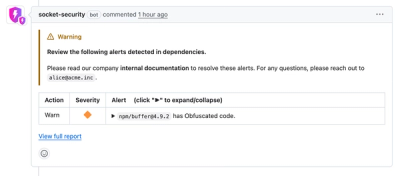
Security News
Crates.io Users Targeted by Phishing Emails
The Rust Security Response WG is warning of phishing emails from rustfoundation.dev targeting crates.io users.
@bartholomej/ngx-splide
Advanced tools

Splide.js integration to angular
https://justcommunication-ru.github.io/ngx-splide/
Using npm
npm i --save ngx-splide
Or if you prefer yarn
yarn add ngx-splide
Add splide.js into your build scripts in angular.json:
"scripts": [
"node_modules/@splidejs/splide/dist/js/splide.js",
]
And styles if you need it:
"styles": [
"node_modules/@splidejs/splide/dist/css/splide.min.css",
"node_modules/@splidejs/splide/dist/css/themes/splide-default.min.css"
]
Add NgxSplideModule into app.module.ts
import { NgxSplideModule } from 'ngx-splide';
@NgModule({
//...
imports: [
//...
NgxSplideModule
],
//...
})
export class AppModule {}
You can use <splide /> root component with <splide-slide /> components inside.
<splide>
<splide-slide>
<img src="image1.jpg" alt="" />
</splide-slide>
<splide-slide>
<img src="image2.jpg" alt="" />
</splide-slide>
</splide>
<splide [options]="{ type: 'loop', perPage: 1, keyboard: false }">
<splide-slide *ngFor="let image of images">
<img [src]="image.src" alt="" />
</splide-slide>
</splide>
Please refer to official documentation for the list of supported options https://splidejs.com/options/
<splide (onInit)="onSplideInit($event)">
<splide-slide>
<img src="image1.jpg" alt="" />
</splide-slide>
<splide-slide>
<img src="image2.jpg" alt="" />
</splide-slide>
</splide>
onSplideInit(splide)
{
console.log(splide);
}
You can programatically change selected splide slide with selectedSlideIndex option
<button type="button"
*ngFor="let image of images; let index = index"
(click)="selectedImageIndex = index">Select image {{ index + 1 }}</button>
<splide [options]="{ type: 'loop', perPage: 1, keyboard: false }">
<splide-slide *ngFor="image in images" [selectedSlideIndex]="selectedImageIndex">
<img [src]="image.src" alt="" />
</splide-slide>
</splide>
Events can be handled in two ways:
<splide
(onInit)="onSplideInit($event)"
(onMounted)="onSplideMounted($event)"
(onUpdated)="onSplideUpdated($event)"
(onMove)="onSplideMove($event)"
(onMoved)="onSplideMoved($event)"
(onDrag)="onSplideDrag($event)"
(onDragged)="onSplideDragged($event)"
(onVisible)="onSplideVisible($event)"
(onHidden)="onSplideHidden($event)"
(onActive)="onSplideActive($event)"
(onInactive)="onSplideInactive($event)"
(onClick)="onSplideClick($event)"
(onArrowsMounted)="onSplideArrowsMounted($event)"
(onArrowsUpdated)="onSplideArrowsUpdated($event)"
(onPaginationMounted)="onSplidePaginationMounted($event)"
(onPaginationUpdated)="onSplidePaginationUpdated($event)"
(onNavigationMounted)="onSplideNavigationMounted($event)"
(onAutoplayPlay)="onSplideAutoplayPlay($event)"
(onAutoplayPause)="onSplideAutoplayPause($event)"
(onAutoplayPlaying)="onSplideAutoplayPlaying($event)"
(onLazyloadLoaded)="onSplideLazyloadLoaded($event)"
>
onSplideMoved(args)
{
const newIndex = args[0];
const oldIndex = args[1];
const destIndex = args[2];
}
<splide (onSplideEvent)="onSplideEvent($event)">
Event object:
{
"name": <event-name>,
"args": <event-arguments>
}
event-name – name of the splide event listed in https://splidejs.com/events/
event-arguments – array of arguments.
For example moved event will be:
{
"name": "moved",
"args": [ 1, 0, 1 ] // newIndex, oldIndex, destIndex
}
onSplideEvent(event)
{
console.log('Splide event', event.name, 'with arguments', event.args);
switch (event.name) {
case 'moved':
const newIndex = event.args[0];
const oldIndex = event.args[1];
const destIndex = event.args[2];
break;
}
}
You can sync splide instances like it described in https://splidejs.com/guides/apis/#sync
Just create @ViewChild in your controller:
@ViewChild('mainSplide') mainSplide: NgxSplideComponent;
@ViewChild('secondarySplide') secondarySplide: NgxSplideComponent;
And pass instances with [syncWith]:
<splide #mainSplide [syncWith]="secondarySplide">...</splide>
<splide #secondarySplide [syncWith]="mainSplide">...</splide>
You can also pass containerClass to append custom class for root div.splide node
<splide containerClass="customSplideClass">
Will produce:
<div class="splide customSplideClass">
...
</div>
FAQs
Splide.js integration with angular
We found that @bartholomej/ngx-splide demonstrated a not healthy version release cadence and project activity because the last version was released a year ago. It has 1 open source maintainer collaborating on the project.
Did you know?

Socket for GitHub automatically highlights issues in each pull request and monitors the health of all your open source dependencies. Discover the contents of your packages and block harmful activity before you install or update your dependencies.

Security News
The Rust Security Response WG is warning of phishing emails from rustfoundation.dev targeting crates.io users.

Product
Socket now lets you customize pull request alert headers, helping security teams share clear guidance right in PRs to speed reviews and reduce back-and-forth.

Product
Socket's Rust support is moving to Beta: all users can scan Cargo projects and generate SBOMs, including Cargo.toml-only crates, with Rust-aware supply chain checks.